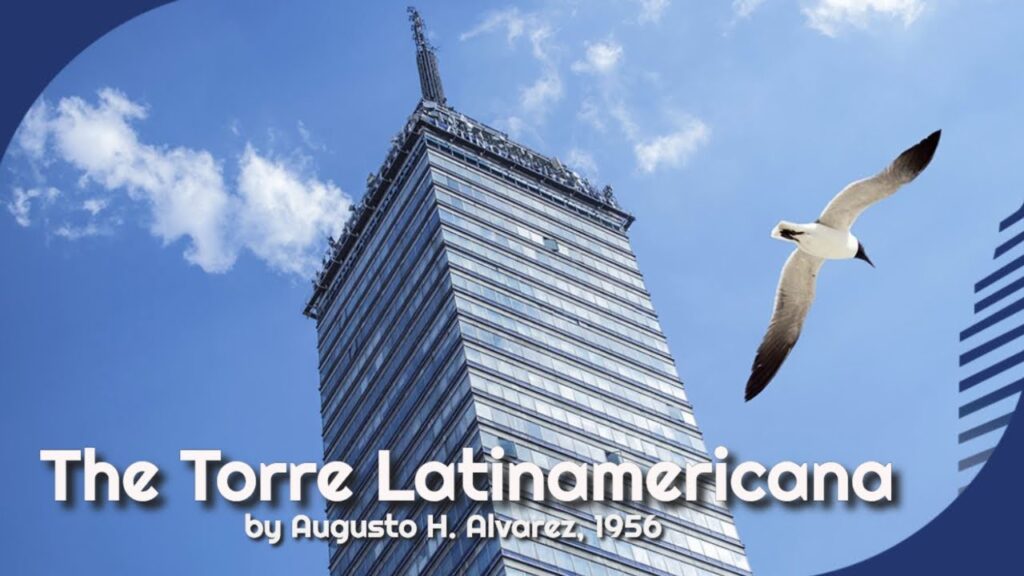The Early Life of Augusto H. Álvarez: The Father of Torre Latinoamericana
Born at the turn of the 20th century in a period filled with remarkable change and growth, Augusto H. Álvarez quickly showed a proclivity for pushing boundaries. In his formative years in Mexico, he was surrounded by the bustling energy of a nation finding its modern identity. His early fascination with the architectural marvels springing up around the world laid the groundwork for what would become a storied career in building design and construction.
Though little is widely known about his earliest days, Álvarez’s journey began as a precocious child amidst the backdrop of the Mexican Revolution. This era of upheaval and transformation no doubt had a profound impact on young Augusto, instilling in him a sense of resilience and a deep understanding of the importance of innovation in overcoming adversity. From an early age, he demonstrated a keen interest in the physical structures that shape society, an interest that would guide his future educational and professional pursuits.
As a young man, Álvarez pursued his education with a fierce determination, eventually leading him to the esteemed National Autonomous University of Mexico (UNAM), where his passion for architecture would take a more formal shape. Here, he absorbed the nuances of architectural theory, form, function, and engineering. His studies were rigorous, and through them, he established a solid foundation of knowledge that would underpin his future achievements. It was this academic environment that helped refine his vision for Mexico’s architectural future.
Álvarez’s early career was marked by an eagerness to innovate within his field. He began to make a name for himself with designs that were ahead of their time, always seeking to balance aesthetic appeal with practical functionality. This period of his life was critical in shaping his architectural approach – an approach that would bring him to conceive the Torre Latinoamericana, a testament to both his forward-thinking mindset and his dedication to his craft. These formative experiences set the stage for Álvarez to become a pivotal figure in Mexico’s urban landscape, changing the skyline of Mexico City forever.
Augusto H. Álvarez’s Architectural Vision and Contributions
Augusto H. Álvarez was a visionary architect who left an indelible mark on the landscape of Mexico. His designs broke away from tradition and helped to modernize cities across the country. Alvarez’s work is characterized by its innovative use of space, light, and local materials, reflecting a deep understanding of Mexico’s cultural and environmental context.
One of Alvarez’s most famous works is the Torre Latinoamericana, an iconic symbol of Mexico City’s skyline. When it was completed in 1956, it was the tallest building in Latin America and an engineering marvel, designed to withstand the region’s frequent earthquakes. This skysra**per, not only demonstrated Alvarez’s forward-thinking in architectural engineering but also his ability to merge aesthetic simplicity with practical function.
In addition to towering skyscrapers, Alvarez’s portfolio includes a range of other significant structures that have contributed to Mexico’s architectural heritage. The Museo Nacional de Antropología, for instance, showcases his commitment to creating spaces that harmonize with their contents. The museum’s design gracefully accommodates the vast array of artifacts and exhibits, drawing on natural light and open spaces to enhance the visitor experience.
Alvarez’s vision extended beyond individual buildings to the urban planning level. He played a major role in the development of Mexico City’s Paseo de la Reforma, one of the most important and beautiful avenues in the city. Alvarez’s influence here is seen in the broad, tree-lined boulevard flanked by monuments and buildings that blend international and Mexican architectural styles, fostering a sense of national pride and cosmopolitan energy.
While Alvarez’s architectural legacy is most visible in his grand constructions, he also contributed significantly to the field through his position as a professor and mentor to younger architects. Through his teachings, he helped to shape a new generation of architects who would continue to push the boundaries of design and sustainability in Mexico. Alvarez’s dedication to his craft ensured that his visionary approach to architecture would inspire Mexican cityscapes for decades to come.
Building the Iconic Torre Latinoamericana: Augusto H. Álvarez’s Legacy
The Torre Latinoamericana is not only a towering figure on Mexico City’s skyline but also a monument to the innovative vision of architect Augusto H. Álvarez. When construction was completed in 1956, it represented a significant achievement of engineering, becoming Latin America’s tallest building at the time. Álvarez, whose architectural brilliance is echoed throughout the tower’s design, was undeniably ahead of his time in anticipating the needs of modern high-rise construction in seismic zones.
Álvarez’s quest for a resilient structure was no mere architectural whim. Situated in a region highly prone to earthquakes, Mexico City demanded a building that could withstand the earth’s tremors. The Torre Latinoamericana boasts a deep foundation and a unique damping system that together have allowed it to survive numerous seismic events, including the devastating earthquakes of 1957 and 1985. It’s a testament to Álvarez’s foresight and his skillful adaptation of technology from other earthquake-resistant structures around the world.
The iconic tower also revolutionized the architectural landscape of Mexico City. Beyond its earthquake-resistant features, it introduced a modernist aesthetic to the heart of the capital. Its sleek lines and glass-and-steel facade reflected a new era of prosperity and progress in post-war Mexico. Today, the building continues to be a symbol of modernization and remains an integral part of the city’s cultural heritage, largely due to Álvarez’s groundbreaking work.
Inside the tower, Augusto H. Álvarez ensured that the building was as functional as it was symbolic. With 44 floors of office space, an observation deck, and a variety of telecommunications facilities, the Torre Latinoamericana catered to a multitude of needs and became a hub for business and tourism. Álvarez’s design highlighted the multi-purpose nature of skyscrapers, blending practicality with iconic form. It wasn’t just a building; it was a versatile monument to architectural ingenuity.
Over the years, the Torre Latinoamericana has stood as an unwavering milestone in Mexico’s urban development. Its construction paved the way for future high-rise buildings throughout the country and the entire Latin American region. Augusto H. Álvarez’s work continues to inspire architects and engineers, driving innovation and fostering a spirit of resilience in urban design. Far more than just an element of the city’s skyline, the Torre Latinoamericana is a lasting legacy of Álvarez’s vision and expertise, a physical embodiment of the harmony between aesthetics and structural integrity in the face of nature’s challenges.
How Augusto H. Álvarez Shaped Modern Architecture in Mexico
If you are drawn to the sleek lines and innovative designs that punctuate the skyline in Mexico, you have likely admired the work of Augusto H. Álvarez. His innovative approach to design has left a lasting imprint on the architectural language of the country. Alvarez was a visionary architect who emerged in the mid-20th century, a time when Mexico was embracing modernity and looking to articulate its own identity through architecture.
Augusto H. Álvarez’s quest for architectural excellence is perhaps most evident in the iconic Torre Latinoamericana. Completed in 1956, this towering landmark was once the tallest building in Latin America and represented a turning point in Mexican construction. Its resilient structure, capable of withstanding seismic forces, marked a pivotal advancement in engineering, paving the way for the possibility of skyscrapers in a region frequently rattled by earthquakes.
An advocate for the fusion of functionality and aesthetics, Álvarez’s work often embodied the principles of the International Style with a local twist. The Mexico City International Airport, another of his notable projects, showcases this blend perfectly. With vast, open spaces and a focus on natural light, the airport was not just a point of transit but a space that offered a modernist welcome to travelers from around the world.
In addition to his large-scale projects, Álvarez had a hand in residential design, where he experimented with space, light, and form. His contribution to housing solutions, particularly in the aftermath of World War II, was vital. The architect efficiently met the demands of a growing urban population with designs that balanced the need for density with the desire for livable spaces.
Without a doubt, Augusto H. Álvarez was instrumental in forging a path for future generations of Mexican architects. His commitment to innovative design and his understanding of the interplay between buildings and their environment continue to inspire contemporary architecture not only in Mexico but across the world. As we walk through bustling cities marked by his genius, it’s clear that Álvarez’s legacy is etched into the very fabric of Mexico’s modern landscape.
Remembering Augusto H. Álvarez: The Impact of His Work on Mexican Culture
Augusto H. Álvarez is a name that resonates deeply within the heart of Mexico’s architectural heritage. Renowned for his innovative designs and significant contributions to the urban landscape, Álvarez left behind a legacy that continues to influence contemporary Mexican culture. His perception of space and passionate commitment to integrating modernism with Mexican identity allowed his work to transcend mere structures, becoming cultural symbols that embody the dynamic spirit of Mexico.
One of Alvarez’s most celebrated contributions was his role in reshaping the skyline of Mexico City. The iconic Torre Latinoamericana, conceived by Álvarez, stood as a testament to both the architectural ambition and technological capabilities of mid-20th century Mexico. The construction of the tower marked a new era in Mexican engineering, symbolizing the country’s readiness to participate in the global conversation of modern architecture. Its resilience to earthquakes has not only made it an engineering marvel but also a beacon of hope and strength for the Mexican people.
Beyond the towering achievements in structural design, Álvarez’s vision extended into the realm of urban planning and development. He was pivotal in the conception of the Ciudad Universitaria (University City), home to the National Autonomous University of Mexico (UNAM). His emphasis on creating a space that harmonized with the natural environment and promoted cultural expression has made UNAM a center for educational excellence and a vital hub for social interaction, perennially influencing the minds of future generations.
Alvarez’s commitment to Mexican culture went beyond his architectural feats. He was a fervent advocate for the inclusion of art within everyday spaces, leading to the integration of murals and sculptures by prominent Mexican artists in his projects. This fusion of architecture and art not only beautified the city but also democratized art, making it accessible to the wider public and fostering an appreciation for Mexico’s rich artistic heritage which continues to ripple through the society today.



